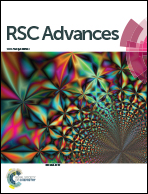Heterojunction conception of n-La2Ti2O7/p-CuO in the limelight of photocatalytic formation of hydrogen under visible light
Abstract
The heterojunction based photocatalyst between La2Ti2O7 and CuO is fabricated by a solid state reaction method. The prepared photocatalyst is characterized by X-ray diffraction, diffuse reflectance UV-vis spectroscopy, high resolution transmission electron microscopy, photoluminescence spectroscopy, X-ray photoelectron spectroscopy, BET surface area and photoelectrochemical measurements. The formation of the heterojunction is ascertained from XRD, HRTEM and XPS analysis. The activity of the photocatalyst is tested towards hydrogen evolution under visible light illumination. The conduction band of CuO is more positive than the hydrogen reduction potential, but after the formation of the heterojunction with La2Ti2O7, the system is able to evolve hydrogen under visible light. This is possible due to the alignment of the Fermi level which leads to the bending of the vacuum level during the formation of the heterojunction. As the vacuum level bends, the conduction and valence bands of La2Ti2O7 and CuO also bend w.r.t. the vacuum level. The bending of the conduction and valence bands make the hydrogen evolution possible. The hydrogen evolution mechanism is established with the help of photoelectrochemical measurements and X-ray photoelectron spectroscopy.


 Please wait while we load your content...
Please wait while we load your content...